Francesca Capone
Deciphering the Language of Fabric
- Coding Poems into Cloth
- Talking Knots
- Publishing in Thread
- Wearing Aphorisms
- Wearing Prayers and Places
- Translation: White and Ivory Left-hand Twill
- Translation: Red and White Left Hand Twill
- Translation: Green and White Right Hand Twill
- Translation: Blue and White Right Hand Twill
- Translation: Black and White Right Hand Twill
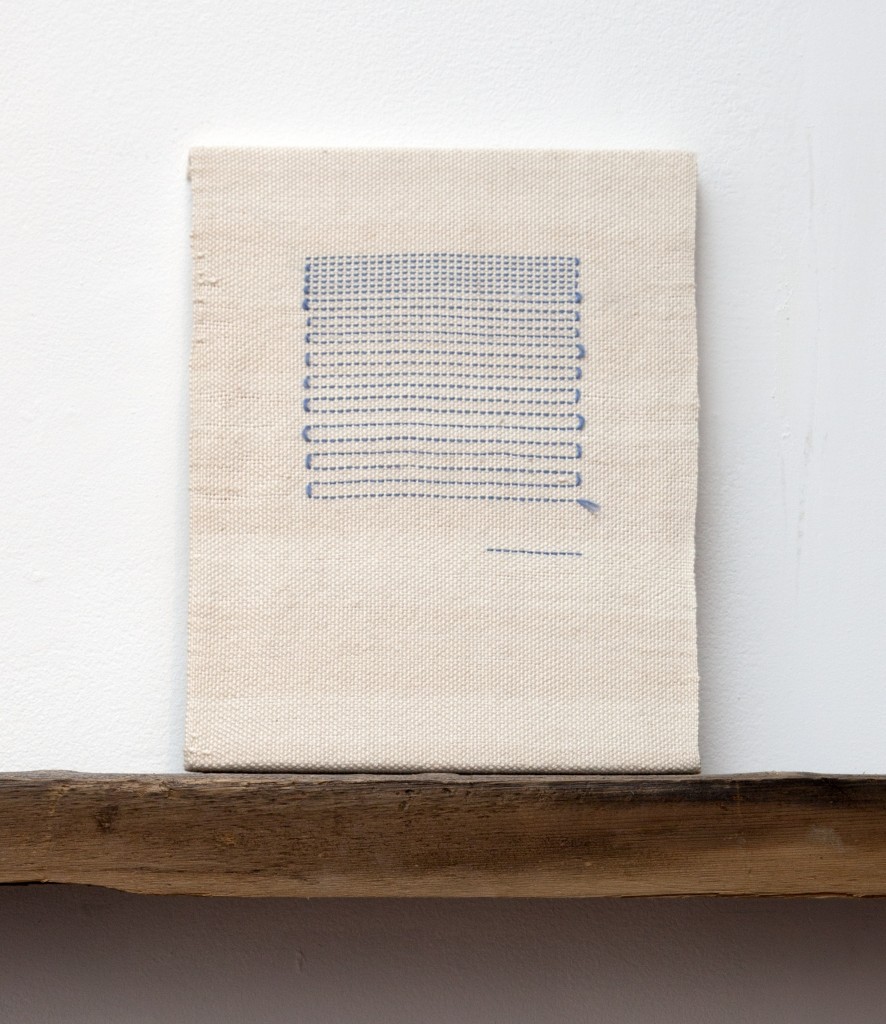
Coding Poems into Cloth
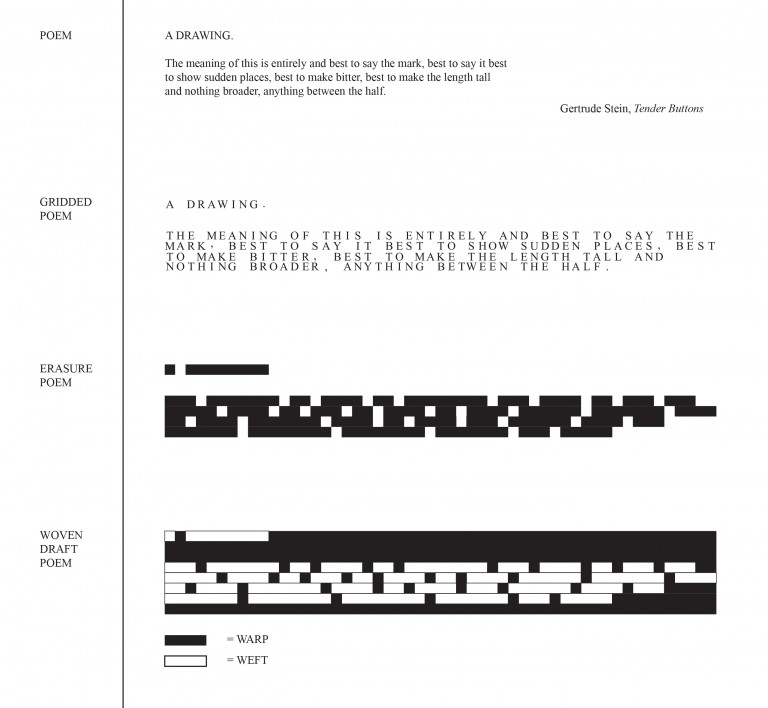
"An ancient metaphor: thought is a thread, and the raconteur is a spinner of yarns - but the true storyteller, the poet, is a weaver. The scribes made this old and audible abstraction into a new and visible fact. After long practice, their work took on such an even, flexible texture that they called the written page a textus, which means cloth. The typesetting device, whether it happens to be a computer or a composing stick, functions like a loom. And the typographer, like the scribe, normally aims to weave the text as evenly as possible. Good letterforms are designed to give a lively, even texture, but careless spacing of letters, lines and words can tear this fabric apart."
—Robert Bringhurst, The Elements of Typographic Style
Considering this structural relationship illuminated by Bringhurst, the image above is my attempt to take typographic form and code it into the woven drafting system. Seeing this as a gesture of drawing a poem in thread, I’ve chosen the initial text from Stein.
Talking Knots
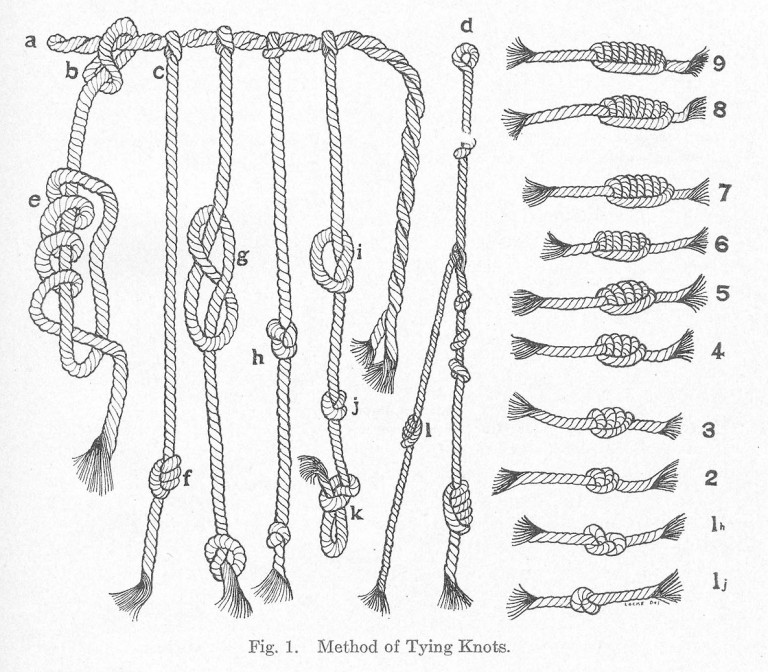
— Pg. 13, Description of the Quipu
Six hundred. There are six hundred remaining Inca quipus that survived both the pillage of the conquistadors and fiber degradation that occurs over time. Anthropologists have gleaned that these knotted fabrics were used for counting and various economic purposes, yet they are still deciphering their meaning. Some hypothesize that the Inca used this system to write poetry. I imagine what an anthology of the remaining six hundred quipus might represent in aesthetics and meaning.
Publishing in Thread
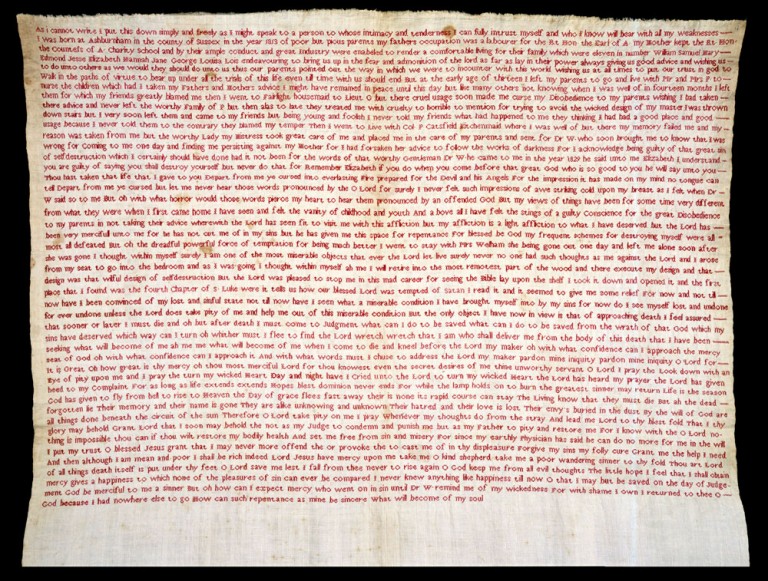
— Sampler, Elizabeth Parker, The Victoria & Albert Museum
Elizabeth Parker, it is impossible not to feel sympathetic towards you after reading your embroidered diary entry from 1830, England. Let us consider what she pleads mercy for: (1) Attempting to write, (2) quitting her first job when she was 13, (3) working for an abusive man, (4) disobeying her parents, (5) falling ill with depression, (6) attempting to commit suicide, (7) continuing to harbor suicidal thoughts, and (8) being an unworthy sinner. I think of publishing as an act of repentance. This embroidered cloth is her prayers manifested, her confessional. It is apparent that Elizabeth thought it more reasonable to embroider instead of picking up a quill — perhaps due to what might have been socially acceptable, or perhaps the act of embroidering was an act of martyrdom, pricking her fingers on her way to earning blessed peace. I think of what it means to ‘publish’ something in thread and the preciousness and permanence of that. I doubt she might have considered that her incredibly personal diary entry would be hanging in the Victoria & Albert museum for all eternity. I think that I am responsible to provide a lengthy-though-truncated quotation transcribed from fiber to print:
As I cannot write I put this down simply and freely as I might speak to a person to whose intimacy and tenderness I can fully intrust myself and who I know will bear with all my weakness — I was born as Ashburnham in the county of Sussex in the year 1813 of poor but pious parents …should end but at the early age of thirteen I left my parents to go and live with Mr. and Mrs.P to — nurse the children which had I taken my Fathers and Mothers advice I might have remained in peace until this day but like many others not knowing when I well of fourteen months I left them for which my friends greatly blamed me then I went to Fairlight housemaid to Lieut G but there cruel usage soon made me curse my Disobedience to my parents …I was thrown down stairs but I very soon left them and came to my friends …For I acknowledge being guilty of that great sin of self destruction which I certainly should have done had it not been for the words of that worthy Gentleman Dr …But my views of things have been for some time very different from what they were when I first came home I have seen and felt the vanity of childhood and youth And above all I have felt the stings of a guilty Conscience for the great Disobedience to my parents in not taking their advice wherewith the Lord has seen fit to visit me with this affliction but my affliction is a light affliction to what I have deserved but the Lord has — been very merciful unto me for he has not cut me off in my sins but he has given me this space for repentance for blessed be God my frequent schemes for destroying myself were almost all defeated but oh the dreadful powerful force of temptation for being much better I went to stay with Mrs Welham she being gone out one day and left me alone soon after she was gone I thought within myself surely I am one of the most miserable objects that ever the Lord let live surely never no one had such thoughts as me against the Lord and I arose from my seat to go into the bedroom and as I was going I thought within myself ah me I will retire to the most remotest part of the wood and there execute my design and that — design was that willful design of self destruction But the Lord was pleased to stop me in this mad career for seeing the Bible lay upon the shelf I took it down and opened it and the first place that I found was the fourth chapter of S. Luke were it tells us how our blessed Lord was tempted of Satan I read it and it seemed to give me some relief for now and not til — now have I been convinced of my lost and sinful state not til now have I seen what I miserable condition I have brought myself into by my sins for now do I see myself lost and undone for ever undone unless the Lord does take pity of me and help me out of this miserable condition …O kind shepard take me a poor wandering sinner to thy fold Thou art Lord of all things death itself is put under thy feet O Lord save me lest I fall from thee never to rise again …The little hope I feel that I shall obtain mercy gives a happiness to which none of the pleasures of sin can ever be compared I never knew anything like happiness til now O that I may but be saved on the day of the Judgement God be merciful to me a sinner But oh how can I expect mercy who went on in sin until Dr W remind me of my wickedness for with shame I own I returned to thee O — God because I had nowhere else to go How can such repentance as mine be sincere What will become of my soul
Wearing Aphorisms
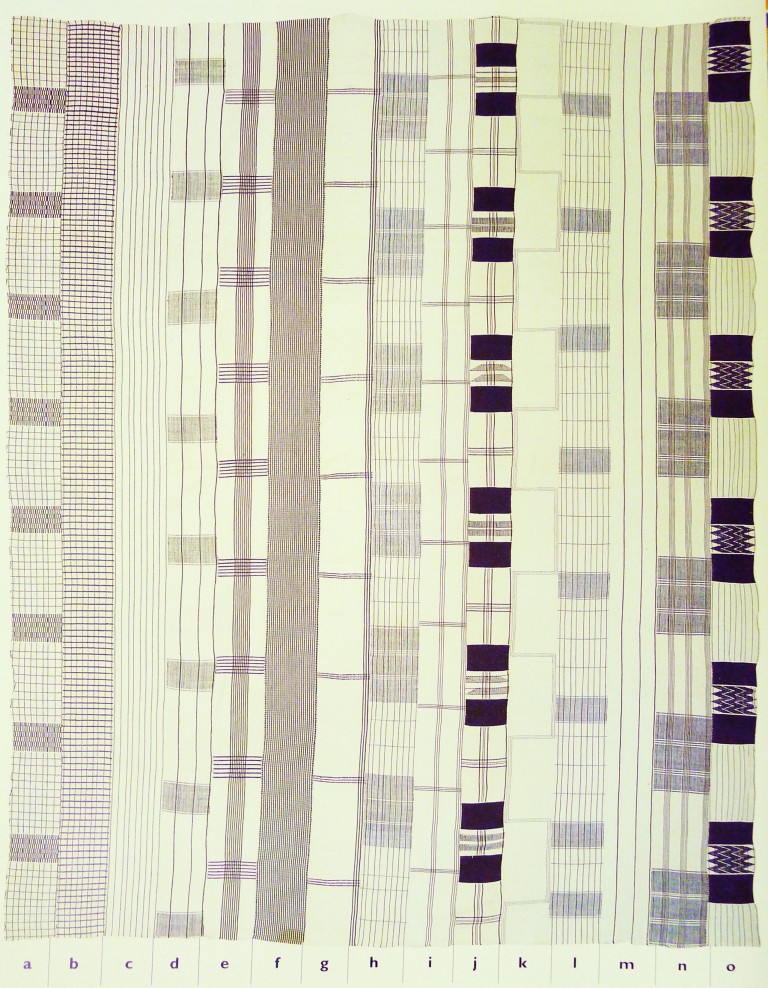
— Pg.120, Wrapped in Pride, Doran H. Ross
Historically a fabric made for Ashanti Kings, Kente has become a symbol of West African culture and can be found all over the Ivory Coast. Since I’ve spent some time in Ghana, I’ll speak of Ghana. Imagine if we all wore Shaker quilts as backpacks, jackets, shoes, or better, if we were wrapped in American flags for special occasions. It’s really difficult to consider an equivalent — perhaps denim? But Canadians wear denim and so does everyone else in the world. When I went to the Ghanaian Embassy in New York City to get my visa, I remember nothing of the room except for an absolutely glorious enormous Kente fabric hanging behind the visa clerk. Kente is woven on very narrow looms with heddles tied to strings that loop around big toes. The thin strips of fabric that are produced are then stitched together to form larger compositions. Each pattern has a specific meaning that relates to proverbs or historical events. The colors all having meanings as well:
red: political and spiritual moods, bloodshed, sacrificial rites and death
pink: female essence of life, a mild, gentle aspect of red
maroon: the color of mother earth, associated with healing
yellow: preciousness, royalty, wealth, fertility, beauty
green: vegetation, planting, harvesting, growth, spiritual renewal
blue: peacefulness, harmony and love
purple: feminine aspects of life
black: maturation, intensified spiritual energy
grey: healing and cleansing rituals, associated with ash
white: purification, sanctification rites and festive occasions
gold: royalty, wealth, high status, glory, spiritual purity
silver: serenity, purity, joy, the moon
Wearing Prayers and Places

— Tiraz Fragment, Metropolitan Museum of Art Online Collection
In the Middle East circa the eleventh century, Tiraz textiles were part of an official ceremony given by the caliph. A turban sash or robe of honor would be worn, feathered with a line of Arabic inscription. Only remnants exist now as evidence of this custom, and the messages found have been translated to discover this particular sequence: a blessing, the name of the caliph, where the fabric was made, and the date. I think of what it means to wear this information. I think of the printed name tags that my mother stitched into all my camp clothes, and the prayer-like nature of that gesture. I think of MADE IN CHINA or MADE IN VIETNAM or MADE IN BANGLADESH and what wearing those places really represents. I think of the fingers and hands, the makers, the people the words embody, and how mysterious the reality of those people remains to me, despite my experience interacting with the fabrics and clothing they have taken part in creating.
Translation: White and Ivory Left-hand Twill
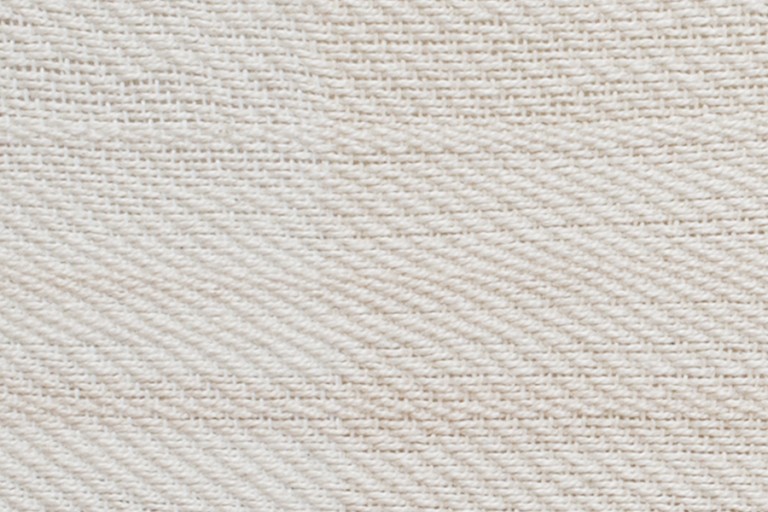
- reclining into memory, you were reminiscent
of the Scandanavian second winter when snow
reflects the sky in day and continues to illuminate
throughout the night, down from zero into
imaginary numbers, suggesting unmarked canvas
as the rawest form of painting, considering zinc
oil paint applied with a sword-like palette knife
invented to create an uninterrupted surface,
what would be more perfect than unexposed
photographic paper never removed from the box
or more tragic than the skin of a child held captive
until she was six, there are tragedies of paleness
too numerous to recount, like how roots pulled out
of the ground can’t know their quality of brightness,
turnips and celeraic, garlic though it is not a root, and salt
in the recessed forms of dried up oceans, minerals spun into
porcelain bowls, or astronauts destined towards the moon
cast up against gravity into clouds and stars - - -
Translation: Red and White Left Hand Twill
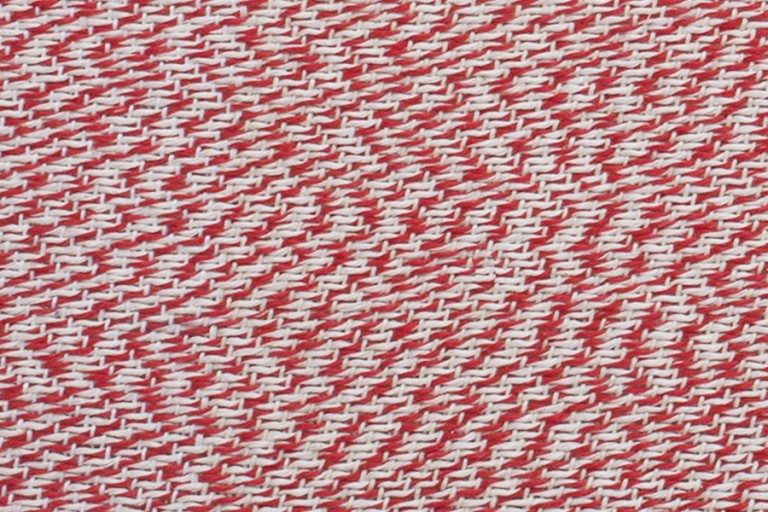
- you travelled southwest to the desert and dug
hands into the earth collecting ruddy pigment
until it stained the skin, hawk and other fauna
embedded in adobe cliffs, a memory of the heart
muscle clenched, mercurial wanderers rest and
wake with volcanic dawn, intricate threads
of capillaries invigorated - - -
Translation: Green and White Right Hand Twill
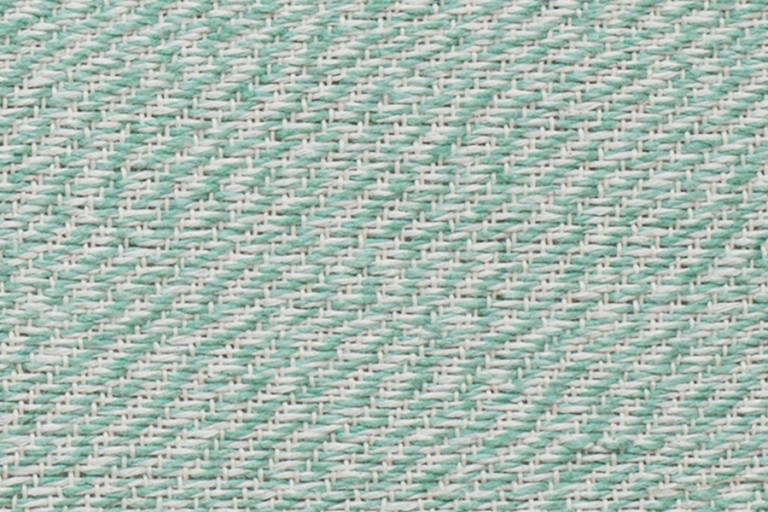
- you travelled southwest to the desert and dug
hands into the earth collecting ruddy pigment
until it stained the skin, hawk and other fauna
embedded in adobe cliffs, a memory of the heart
muscle clenched, mercurial wanderers rest and
wake with volcanic dawn, intricate threads
of capillaries invigorated - - -
Translation: Blue and White Right Hand Twill
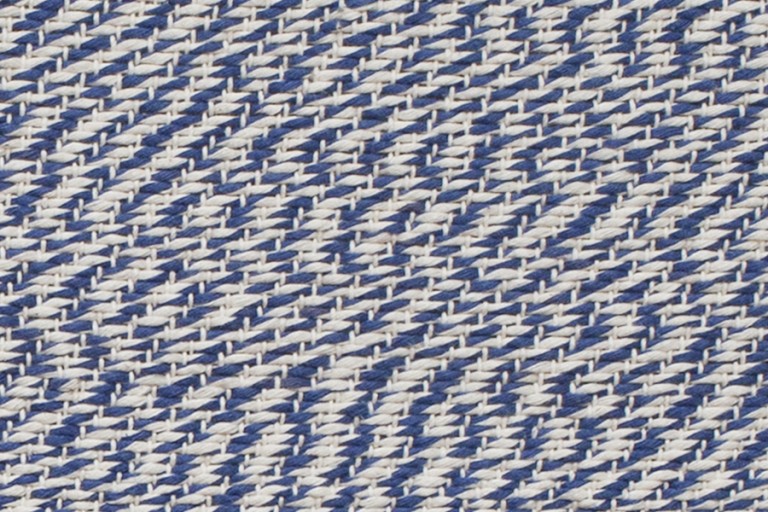
- you travelled southwest to the desert and dug
hands into the earth collecting ruddy pigment
until it stained the skin, hawk and other fauna
embedded in adobe cliffs, a memory of the heart
muscle clenched, mercurial wanderers rest and
wake with volcanic dawn, intricate threads
of capillaries invigorated - - -
Translation: Black and White Right Hand Twill
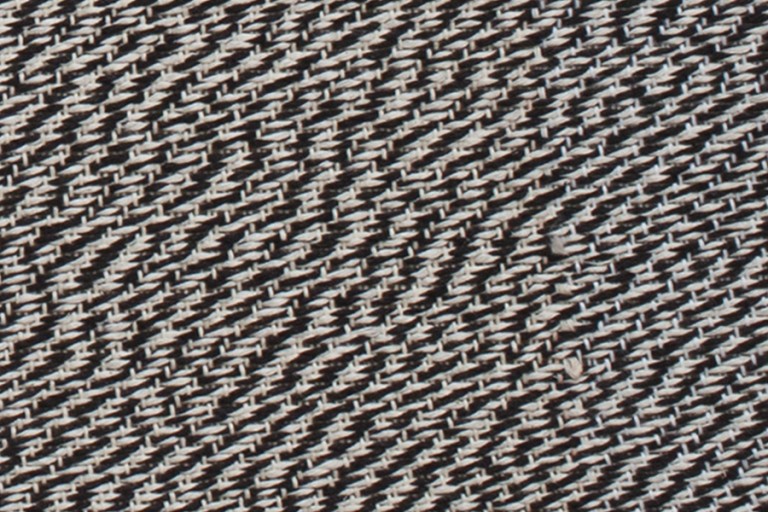
- you travelled southwest to the desert and dug
hands into the earth collecting ruddy pigment
until it stained the skin, hawk and other fauna
embedded in adobe cliffs, a memory of the heart
muscle clenched, mercurial wanderers rest and
wake with volcanic dawn, intricate threads
of capillaries invigorated - - -
Francesca Capone
Francesca Capone is an artist working at the confluence of visual art and experimental literature. Her most recent exhibition and publication, Writing in Threads, explores contemporary and historical relationships between weaving and writing. She is the author Primary Source (Gauss PDF, 2015) and was included in the visual poetry anthology The New Concrete (Hayward Press, 2015). She currently lives in Portland, OR.